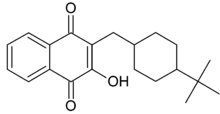Buparvaquone
 | |
| Clinical data | |
|---|---|
| ATCvet code | QP51AX22 (WHO) |
| Identifiers | |
| |
| CAS Number |
88426-33-9 |
| ChemSpider |
10807457 |
| UNII |
0354RT7LG4 |
| ChEMBL |
CHEMBL292009 |
| ECHA InfoCard | 100.115.556 |
| Chemical and physical data | |
| Formula | C21H26O3 |
| Molar mass | 326.435 g/mol |
| 3D model (Jmol) | Interactive image |
| |
| |
| | |
Buparvaquone is a hydroxynaphthoquinone antiprotozoal drug related to parvaquone and atovaquone. It is a promising compound for the therapy and prophylaxis of all forms of theileriosis. Buparvaquone has been shown to have anti-leishmanial activity in vitro. It can be used to treat bovine East Coast fever protozoa in vitro, along with the only other substance known - Peganum harmala. It is the only really effective commercial therapeutic product against bovine theileriosis, where it has been used since the late 1980s.
Industrial production
It was first produced in Great Britain, then in Germany. Its patent expired in the mid-2000s, and was then produced in different countries, e.g. India and RAZAK labs co. of Iran
Use in bovine theileriosis
Using a single dose of 2,5 mg/kg, the recovery rate of curable cases is 90 to 98%. In tropical theileriosis, a dosage of 2.0 mg/kg has the same efficacy. Body temperature returns to normal in two to five days. Parasitemia lowers from 12% on day 0 to 5% the next day, then to 1% by day 5 and none at day 7.[1]
References
- ↑ Abou-El-Naga et al., Beni-Suef Vet. Med. J. 2005.